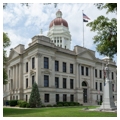The focal point of downtown Seward, the courthouse occupies the center of a square block within a grid and is surrounded by a wall of commercial buildings. This arrangement is the most common type of courthouse square but is unusual, even rare, in Nebraska and other states west of the Missouri River.
The courthouse is a rectangular, three-story, flat-roofed structure that displays elements of the Classical Revival style. The facades are clad in smooth limestone with the mortar joints on the first floor raked to give a rusticated appearance to the base. Each elevation is strictly symmetrical with a five-part composition consisting of a central pavilion with a squared top and pediment and projecting corner towers capped with low bulbous domes. The north pavilion, marking the primary entrance, features two pairs of coupled columns with Corinthian capitals framing the single round-arched entry. Each of the other three pavilions has an entrance consisting of three small archways that form a ground-floor arcade surmounted by four engaged Corinthian columns. The corners of the towers have Corinthian pilasters. All window openings are rectangular with simple surrounds except the first-floor corner windows that are detailed with pediments and consoles. A notable feature of the courthouse is the ribbed dome supported by a tall octagonal drum that rises from the center of the building. The drum is richly detailed with engaged columns, pilasters and pediments. While alterations to the exterior have been minimal, the interior has undergone numerous changes including new wall partitions, wood paneling, dropped ceilings, and fluorescent lighting. The original plaster capitals and moldings, terrazzo floors, marble stairs, and metal balusters and newels have been retained.
The Seward County Courthouse is a fine example of the work of George A. Berlinghof, an important Nebraska architect. Berlinghof designed a number of courthouses including eight in Nebraska and four in other states. Two of his Classical Revival courthouses are very similar in design to the Seward building, all of which were built between 1904 and 1907. They include the Kearney County Courthouse in Minden, Nebraska, and the Crawford County Courthouse in Denison, Iowa.
Most of the commercial buildings ringing the square are two-story brick structures that date from the late nineteenth and early twentieth centuries. Those erected in the late 1870s and early 1880s display design features of the Italianate style. The sense of architectural cohesiveness created through a common scale, compatible materials, and continuity in fenestration provides a dignified context for the courthouse, which rises above the surrounding buildings. Today the courthouse and the surrounding commercial buildings are included within and define the perimeter of the historic district.
References
Kidd, Daniel and Linda Syverson, “Seward County Courthouse,” Seward County, Nebraska. National Register of Historic Places Inventory–Nomination Form, 1980. National Park Service, U.S. Department of the Interior, Washington, DC.











